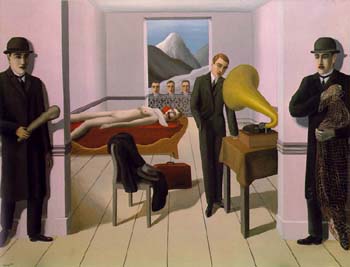|
Once again, research
shows a connection between watching television and
warring tendencies. And again, museums get away with murder.
Columbia University professor
Jeffrey Johnson and the New York Psychiatric Institute,
studying 700 New Yorkers over 17 years, found that when
young teens watch television for more than one hour a
day, they are liable to become violent adults. Apparently
TV fare gives couch potatoes a capacity for cruelty.
Somebody ought to look
into museum fare. If parents think to send their kids
off to fine art shows to spell them from TV images of
sleaze and slaughter, they ought to consider these exhibit
examples and the things art experts say about them.
"Rape of the Daughters
of Leucippus" by Peter Paul Rubens shows two unclothed
females forcibly taken by a pair of burly young men on
horseback. Kerry Downes, a British authority on Rubens,
has said that "romance, not,
violence, is the keynote," as if the painting were a pastoral
and these women weren't struggling against abduction.
Downes, oblivious to the fever pitch of the crime scene,
compared it to a "free-standing sculpture, isolated in
space by the low horizon and distant landscape, and touching
the ground only at a few points of balance." One of those
points of balance, by the way, is an arm of a woman reaching
for the ground as she's being yanked upward. You can almost
hear a full-throated scream coming from her. Apparently,
Downes has been looking at the Rubens so long that he's
become inured to the rising panic of the women and the
fever pitch of their attackers.
 |
|
"Jupiter
and Io" by Corregio
|
"Jupiter and Io" by Corregio
shows another accosted and nude female, this time raped
by a god disguised in the form of a dark and menacing
cloud. Corregio expert Frederick Hartt has described it
this way: "The image is so
frank, so open, so direct, so real, that it cannot conceivably
be classed as pornography."
Evidently, if a rape is
committed out in the open, it's a forthright exchange
and not a rape at all.
Noted art historian, Kenneth Clark has said of "Jupiter
and Antiope," another rape painting by Corregio (quite
a guy, this Corregio), "As our eyes follow every undulation,
it passes refreshed from shade to light." Like Downes,
Clark doesn't recognize that a rape is taking place.
Neither does art historian
Anthony Janson who has written of Jan Steen's "Rape of
the Sabine Women"—a pictorial of smirking attackers
tearing women from their loved ones—that
the artist "explored human folly with endless
good humor." Janson also used terms such as "peasant revel"
and "ebullient action" to characterize the assault.
Then there's Cezanne's
thick, dark, crude-stroked paintings of bloody stabbings,
stranglings, rape and other cruelties. Describing the
tortured scenes, art aficianado Robert Simon used words
like "idiosyncratic commingling" and "esthetic density."
He also excused scenes of cannibalism and decapitation
by painter Theodore Gericault, by blaming the "virulent
social anxieties of the Second Empire." (In short, the
devil made him do it).
In a similar way, art expert
Edwin Mullins excused Hieronymus Bosch's violent depictions
in "The Hay Wagon," which shows a woman, her arms tied
behind her back, lying on her back nude except for a black
toad perched on her genitals. Mullins said Bosch painted
it at a time when Roman Catholic misogyny was at its most
hysterical. (Feel better?) Apparently it's OK to be goatish
and foul, as long as you call it art.
 |
|
"The
Menaced Assassin" by Rene Magritte
|
Which makes you wonder
what these experts would say about Rene Magritte's "The
Menaced Assassin" at New York's Museum of Modern Art.
It isn't so much the sight of a nude female spread-eagled
on a table while six fully
clothed males stand around—one
with a club—although
that's bad enough. It's that the picture parts are rendered
like items in an illustrated dictionary: so dully, so
ho-hum, that it denies the reality.
None of this is to say that
horrific images seen in museums prompt horrific acts.
Neither is this asking for censorship of these images.
But showing them without sensitivity to the subject matter
can send the wrong message—provided
anyone is around to listen, that is. If teens ever get
wind of high art, start checking minivans for gun racks.
|